Text

Edo period types of hakama pants, fantastic chart by Edo-lover Nadeshico Rin. You can see here from left to right, top to bottom:
Fundomi hakama 踏込袴 - pants with a narrow bottom hem, a type of nobakama (see below)
Tattsuke hakama 裁付袴 - pants tight below the knee, sometimes refered as "ninja pants" (= Iga hakama). Those were worn by many, from samurai to servants and craftmen.
Umanoribakama 馬乗袴 - lit. "riding pants", wide hakama with high gusset split legs for confortable horse riding.
Nagabakama 長袴 - formal trailing hakama worn by samurai from late Muromachi era.
Andonbakama - skirt-like hakama worn by Meiji period female teachers and students (hence why it's sometimes called onna bakama). A boy version appeared after mid-Meiji.
Yamabakama 山袴 - daily-life work pants with narrow legs and sometimes a gathered bottom hem. Name greatly varies depending on areas and time. A direct descendant of this style are women's monpe もんぺ.
Nobakama 野袴 - shorter hakama with black velvet hem, worn by travelling samurai. It was also part of firefighters' gear.
Hirabakama 平袴 - the "classic" ankle lenght men hakama pants, with a low gusset which means it looks nice when sitting (tailoring is hence different from the umanori, see above). Also called hanbakama 半袴, those were longer than the ancient kobakama 小袴 and shorter than formal trailing nagabakama (see above).
1K notes
·
View notes
Text

Edo period women obi knots, fantastic reference chart by Edo lover Nadeshico Rin.
You can see here several obi musubi favored by city women, of all class and status. Novelty knots were a fashion statement, often lauched by star onnagata kabuki actors, and spread by iki fashionistas such as geisha.
For top to bottom, left to right, you can see here:
Chidori musubi (plover knot) ちどり結び
Shôryû musubi (little dragon knot) 小龍結び
Kichiya musubi (Kichiya knot) 吉弥 結び - named after onnagata actor Uemura Kichiya I in Genroku period, who single handedly launched a new type of knots and obi fashion
Koman musubi (Koman knot) 小万結び - named after a kabuki character in play Yakko no Koman
Nagoya obi (Nagoya belt) 名古屋帯 - Azuchi Momoyama/Early Edo era silk kumihimo tied in butterfly knot
Yanoji musubi (arrow knot) 矢の字結び - created by onnagata actor Segawa Kikunojo II. Also found under the name tateya musubi 立て矢結び (standing arrow knot)
Yoshio musubi (Yoshio knot) よしお結び
Mizuki musubi (Mizuki knot) 水木結び - onnagata actor Mizuki Tatsunosuke is said to have first worn this variation of the Kichiya musubi
Rokô musubi (rôkô knot) 路孝結び - created by onnagata actor Segawa Kikunojo II
Karuta musubi (card knot) カルタ結び - created in early Edo period, looking like 3 playing cards side by side
Hitotsu musubi (single knot) 一つ結び - during Edo, was also called darari musubi だらり結び. Note that it differs from is nowadays called darari obi (worn by maiko)
Tate musubi (standing knot) 立て結び - see yanoji/tateya musubi for variations
Bunko kuzushi (unbalanced knot) 文庫くずし
Heijûrô musubi (Heijûrô knot) 平十郎結び - created by actor Murayama Heijûrô III
Sageshita musubi (falling knot) さげ下結び
(by request of @fireflybettle, hope this will help you ^^)
2K notes
·
View notes
Text

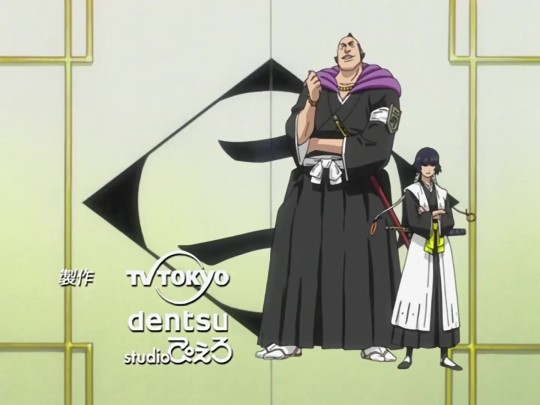









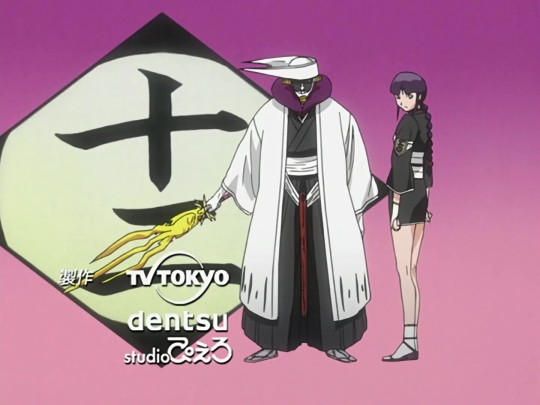
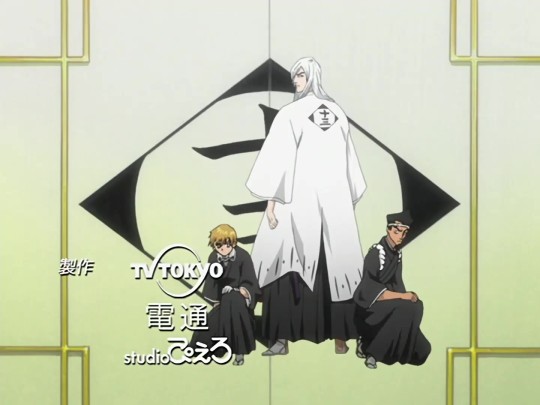
I needed references for all the captain/lieutenant power poses at the end of Hōkiboshi and I thought that maybe you might too
#bleach#shinigami#lieutenants#captains#endings#gotei-13 picture day#yumichika really ought to be lying in front of squad 11 on his side like a peewee ice hockey goalie. just one woman's opinion#obsessed with the fact that sasakibe iba and hisagi are all in an identical squat but renji is in a different squat#like 'this is MY way of the ninja'#or maybe byakuya has very victorian sensibilities#'renji i don't want anyone looking at my ankles can you possibly 'manspread' a little more'#i just remembered i don't usually put dumb tags on this blog oops too late now
21 notes
·
View notes
Text














Got a request from @rurodraws for some shihakushou references in various poses, so please enjoy this enormous dump of shinigami running/jumping/squatting on things like the little scrungly monkeys they are.
Also, here are a couple pics from the settai that might be helpful.


Let me know if there's anything more specific you need, I literally just did this until I got tired of it.
10 notes
·
View notes
Photo
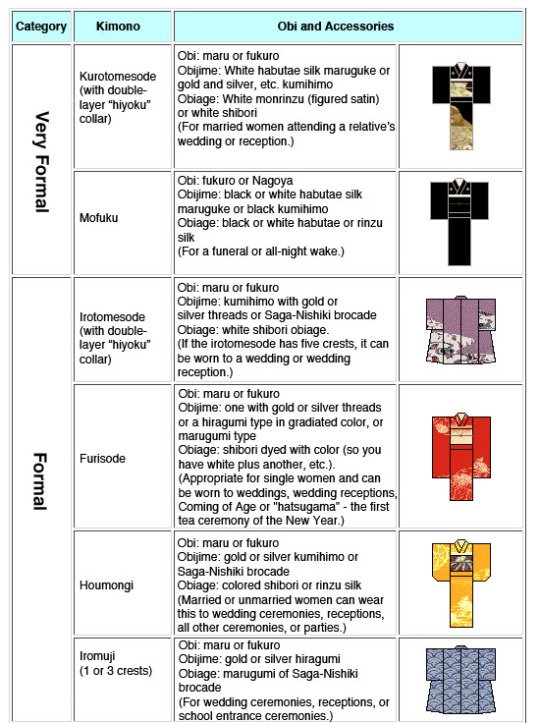
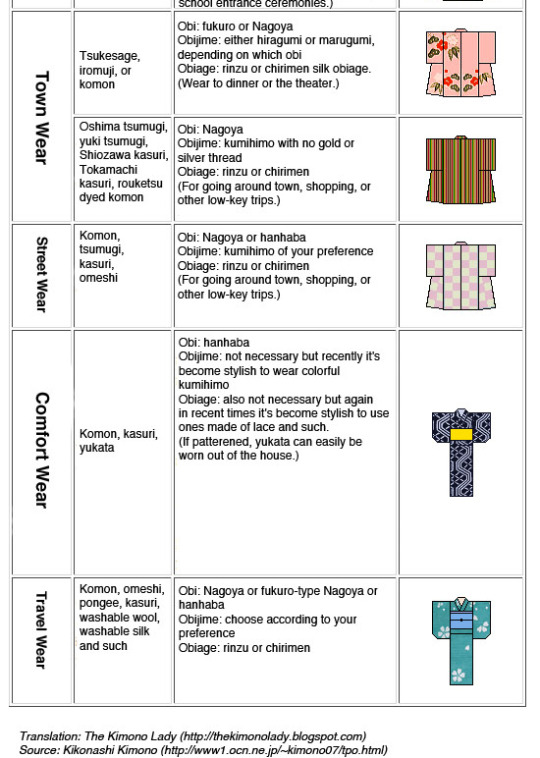
Different types of kimono.
#kimono#writing reference#it's nice to have these in such a compact chart because you can always google the specific terms if you need more details or drawing refs
7K notes
·
View notes
Photo


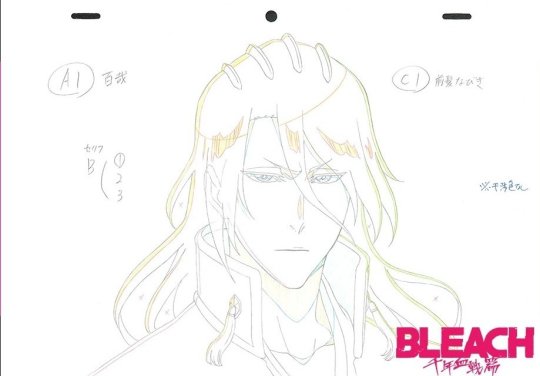

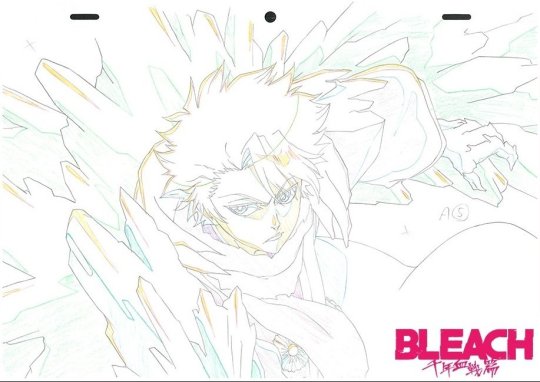

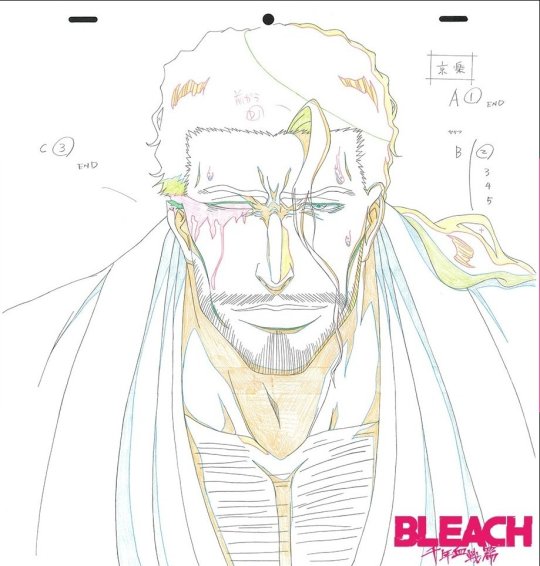

Bleach Ep 4 Animation Sketches
255 notes
·
View notes
Photo

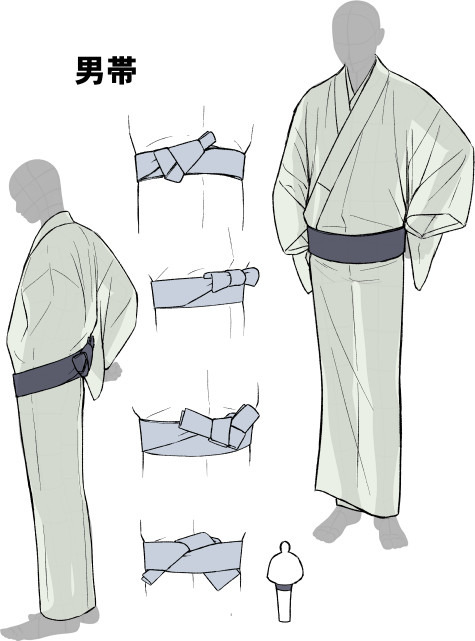








Kimono drawing guide 2/2, by Kaoruko Maya (tumblr, pixiv, site). Booklet is available in pdf for ¥ 900 here.
Here you can see :
Women belt knots examples
Men belt knot examples (and how the obi sits on men body)
About obi: soft obi (heko obi), women obi width (fold is up), men obi width
Coats: haori and michiyuki (note the bump when a woman wears a coat: that’s her obi knot beneath)
differences bewteen kimono and haori when a man bows
Hakama pants
examples of men hakama
Iga Hakama (ninja pants) and women hakama
Miko priestress attire
Working garb: tasukikake (way of tying up sleeves) and shiri hashori (tucking hem up) + formal girl dress and example of child in kimono
12K notes
·
View notes
Text
I have to say that one of my favorite little aesthetic details in Bleach is the Lieutenant’s Badges. The captains have haori, this entire extra garment, which completely sets them apart immediately from other shinigami by shunting them into negative color space. A haori is also very widening, which I think really helps out guys like Byakuya and Gin who are naturally kind wispy. Its got their number on the back, which is almost like a joke, because if you’re seeing the back of a captain, it’s most likely that you’re lying on the ground in a pool of your own blood, and which one did it to you is a bit of a moot point.
Lieutenants, on the other hand, get armbands, which not only have their number, but also their squad flower. They come in one size, which is “burly dude who never skips arm day.” They are required for certain official business, like Emergency Vice Captains Meeting and…um… it’s incomprehensible, actually. Kubo absolutely does use the wearing of them for symbolism, for example, Kira and Hisagi pointed did not wear theirs to the Battle at Fake Karakura Town, although the lieutenants who had not been betrayed by their captains did…and so did Hinamori.
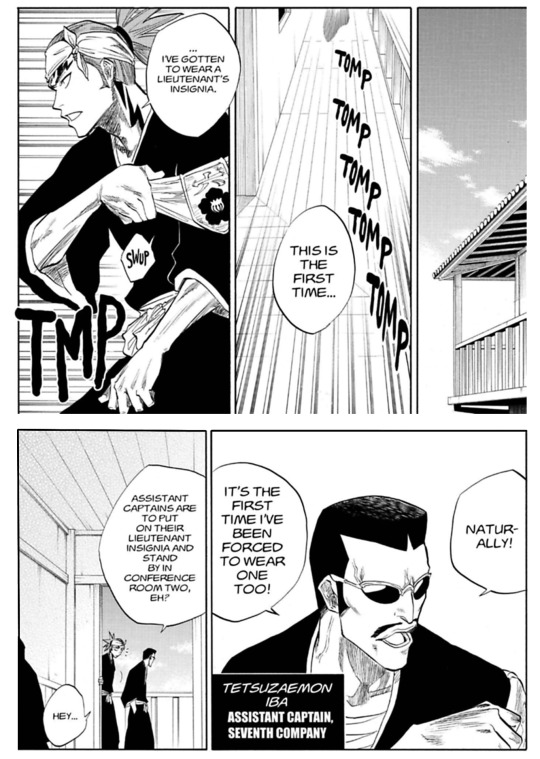
It also seems to be the case that you can wear your badge whenever you want to. It seems to be mostly the women vice-captains that do this, which is sort of funny to me, because they are enormous, and Rukia and Momo in particular look constantly in danger of getting theirs caught while trying to go through a doorway. I imagine this is because guys like Omaeda and Iba and Renji (king shit of not wearing his badge) are used to establishing authority through their physical presence and general volume, whereas lieutenants like Ise and Kotetsu prefer a more tangible symbol of their command. (I think that Rukia just wants everyone to know she’s a lieutenant 100% of the time).
You don’t even strictly have to wear them as an armband. Matsumoto clips hers to her sash (which she ties in a non-standard knot) and Akon wears his one a fucking lanyard (I can only imagine he keeps his access card for swiping into the Squad 12 computer lab in a little pocket on the back side)
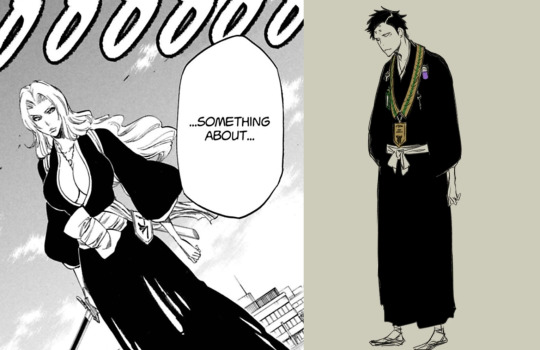
Anyway, none of it this is actually what I wanted to talk about. What I wanted to talk about, is what are the badges feel like. What is their heft, what is their texture? Going into this, I thought they would either be made of metal or wood, but in the course of doing this, I think Kubo original intended for the badges to be soft and then changed his mind.
Keep reading
133 notes
·
View notes
Photo



Byakuya Kuchiki // bleach anime production materials
70 notes
·
View notes
Text
Cat Yoruichi Reference Dump


A small selection of Yoruichi in cat form, including the cutest Cat Yoruichi pic of all time
#shihouin yoruichi#cat yoruichi#polynya project references#yoruichi is REALLY HARD TO DRAW because her features disappear in all the black#animals
5 notes
·
View notes
Text
Shiba Ganju Reference Dump
Hi, who wants to see my extensive collection of pictures of Shiba Ganju’s awful face?









I don’t really have any excuse for this, aside from the fact that his face is incredibly expressive and as someone who is trying to get good at exaggerated reaction shots, this dude is where it’s at.
Oh, a fun thing that I noticed while drawing him is that he has a lot of facial features in common with Isshin, including the nose, the eyebrows, and the shape of the jaw, as well as making a lot of the same aforementioned dramatic faces. This was obviously a neat bit of visual foreshadowing on Kubo’s part, but you can also use them as references for each other, and these might be some things to emphasize if you’re going for a family resemblance.

Things to remember while drawing Ganju:
Goofed up left eyebrow (probably a pair of scars)
Sideburns
Often wears tekkou (wrist guards)
Shiba eyelashes
#shiba ganju#shiba clan#soul society arc#shiba isshin#this is honestly a deranged number of pictures of ganju#i feel like he's my favorite backstreet boy or something#I specifically went looking for that picture of himself he drew on the map it’s very important to me
6 notes
·
View notes
Text
Shiba Kuukaku Reference Dump, p2
While I was putting together my reference dump for Kuukaku, I suddenly remembered that she owns a baller cape that she clearly got at the same cape store where Byakuya shops, and my interest-based nervous system felt the need to immediately go look up that part. It turns out there were a number of very good full-body shots, some close-ups of her footwear situation, and probably a better shot of her tatt than I found in the earlier chapters.
I haven’t actually used any of these for drawing references, I figured that as long as I was organizing, I might as well stick them in the same place.



#shiba kuukaku#polynya project references#shiba clan#capes#p sure kuukaku is the most baller person in soul society#the lil 'you're looking lovely as ever!' 'thanks!' is just sending me#kuukaku would never kiss a man but she appreciates the effort#gosh she's so cool i just love her
6 notes
·
View notes
Text
Shiba Kuukaku Reference Dump, p1
I was recently drawing a comic that returned Shiba Kuukaku and Ganju. This was my first time drawing either on of them, so I ended up collecting a ton of references. I’m trying to get in the habit of organizing my references after the fact so that a) I can delete them from my main camera roll and b) they are organized in case I want to use them again later. I like to collect multiple small references into one shot because that’s easier to import into my drawing program later and then I can copy the ones I want onto their own layers. This fits very well into my own work flow (I also keep big sheets of, like, 100 ears or 20 hands). Anyway, here are some Kuukakus.
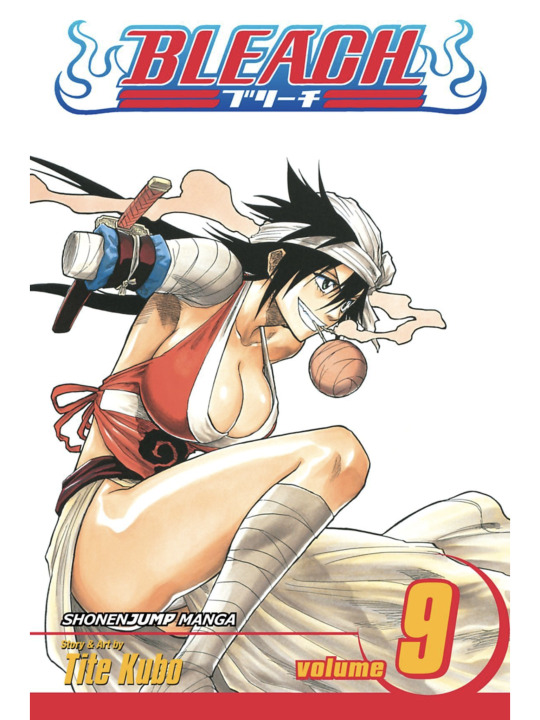
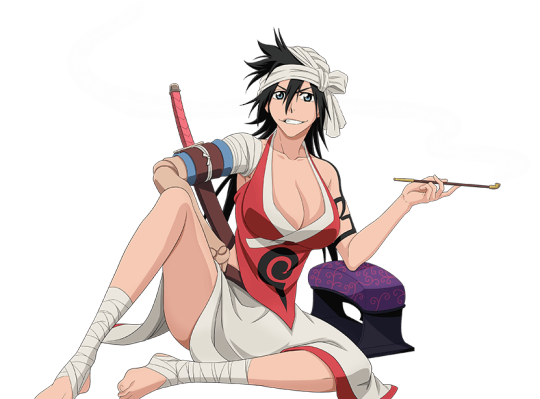
Faces
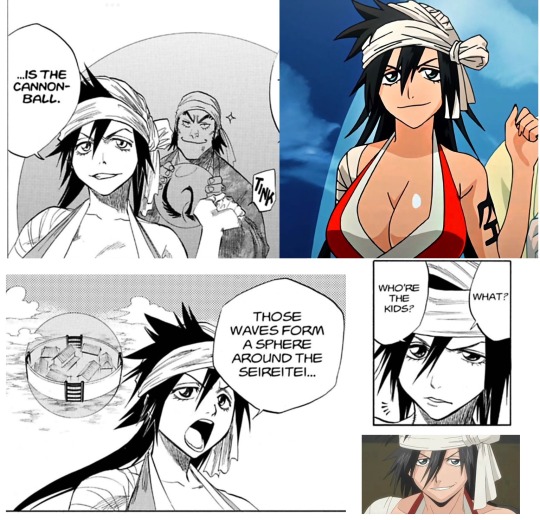
More faces
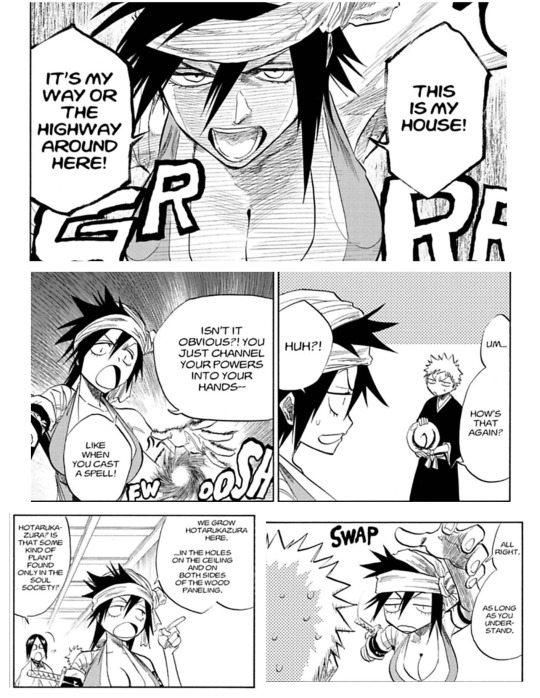
Body shots
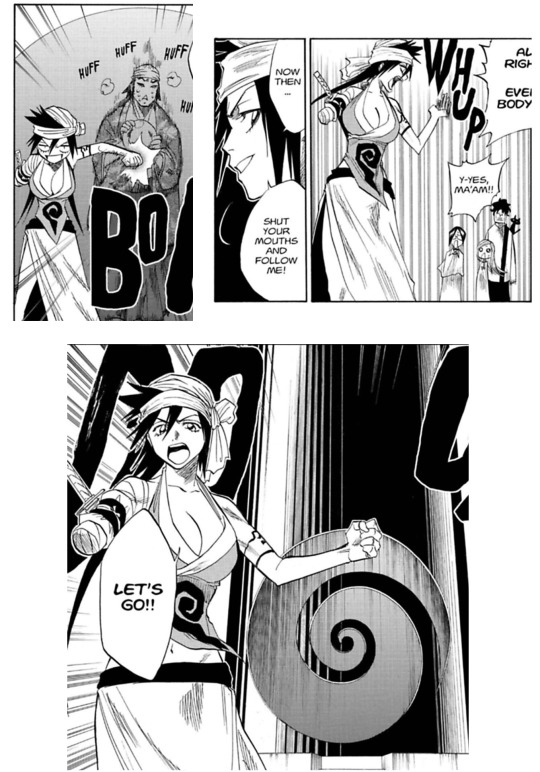
Back and side

Unfortunately, none of these have a really clear shot of her sky tattoo. I did have one really useful reference that I found on Google images, but it had a great big “do not repost” watermark across it, so to compromise, here is a picture *I* drew of her tattoo, and a bonus one that has a good shot of the design on her shirt (It’s the Shiba family symbol, the Collapsing Whirlpool of the Crashing Heaven. Ganju has it on his battle pants, and Kaien had it as a forearm tattoo).

Some observations I made while drawing Kuukaku:
In the anime, Kuukaku has a prosthesis (you can see it a little in the second image), but this is never shown in the manga. I like to stick to the manga, so I didn’t bother with it.
Kuukaku keeps her sword tied to her right arm. The armband she wears actually looks a lot like Yoruichi’s hair tie.
Kuukaku’s hair is in sort of discrete chunks. She has one on either side of her face, one in the middle, and one that sticks out of her head wrap. In the back, her hair is long, and separates into two parts, which I assume is suppose to be evocative of a swallow’s tail.
Her skirt is slit on the right side
It took me a while to figure out her head-wrap, but it’s not actually that hard to draw once you get used to it. Draw the part that goes across the forehead first, it’s almost exactly like drawing Renji’s Standard Bandana, except the knot is all the way on the side. The knot has a loop and a drapy bit. The last bit just follows the contours of the top of her head, and you can divide into a couple of strips.
Do not forget the Shiba eyelashes. The Shiba eyelashes are vital.
2 notes
·
View notes
Photo

Helpful chart by @hilnama showing how to tuck hakama pants to keep shins and ankles free
#shinigami#hakama#more INCOHERENT SCREAMING#this is basically the japanese version of girding your loins right?#anyway i go completely nuts whenever someone in an anime does this#peak character design
452 notes
·
View notes
Photo



About Men and Women Hakama, by Kaoruko Maya (tumblr, pixiv, site).
in bonus: a few drawing of tasuki sleeves holder, mon (crest) position on haori coat, and how kimono pattern should be drawn (illustrated with stripes).
#hakama#shinigami#incoherent screaming#btw the sash used to tie back the sleeves is called a tasuki#note that the women's hakama are much higher-waisted than the mens#i always found it interesting that shihakushou are unisex tho#this is really cool detail except that because shihakushou are black i always end up drawing them as a big blob 😂#i mean so does kubo
2K notes
·
View notes
Photo


So as best i can tell, the sandals of the shihakusho are a kind of waraji- woven straw shoes, tied in a variety of styles. Some sandals had backs, some didn’t. Also, they seem a bit longer than usual- I’ve read that the ends of the toes usually hang over the edge of waraji for gripping purposes, but that probably doesn’t look quite as cool to draw.
I also imagine that soul reaper waraji, being made from reishi presumably, last longer than a single day’s worth of heavy wear (what?!) but it is very funny to imagine a seireitei cleanup detail traveling around, reclaiming stacks of worn out straw sandals piled up wherever they got tossed out.
(first image is from the bleach settei/ second is from Home Life in Tokyo 1910, by Inouye Jukichi, pg 128)
#shinigami#clothing#yes yes YES this is the content i am here for#it took me a long time to figure out how these worked#so here's hoping this saves someone some trouble
33 notes
·
View notes
Photo







Apt. 202- Orihime’s home
#inoue orihime#karakura kids#locations#backgrounds#production materials#i am ::sobbing:: at the way the meat tv is just plopped in the middle of this
173 notes
·
View notes